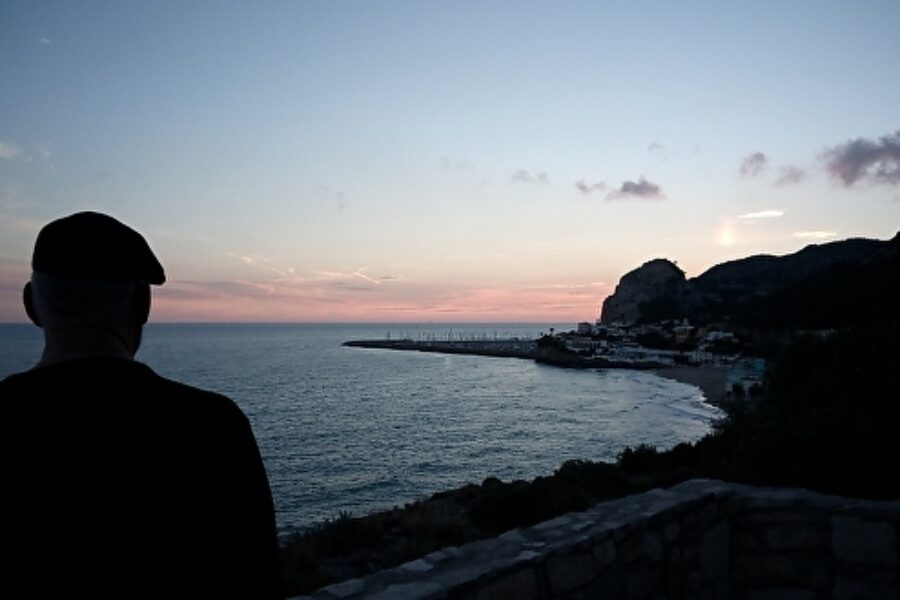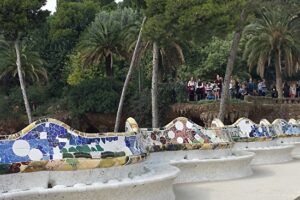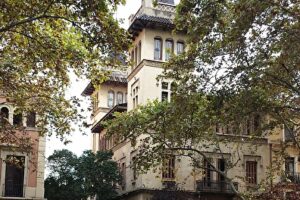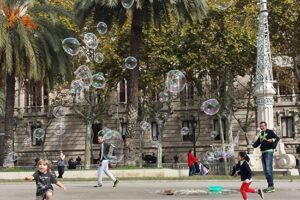Viator’s Explore Catalunya
Explore Catalunya is becoming a habit, but some of our stops are like being offered an ice cream cone piled high with coffee gelato and then having it taken away from me after one tiny lick. I never get my fill of a place traveling with them, but we have seen things we probably wouldn’t have found on our own. Today we hope to see Tarragona.
We leave the Urquinaona metro station, cross the street, and walk to our early morning coffee shop, waiting for 8:00 a.m. and the tour agency doors to open. At least with the time change, we walk in daylight, not dark.
Checking in, the place is virtually empty compared to the chaotic busyness of two weeks ago, but it is a Wednesday. It is November. Maybe tourist season is finally at low ebb? Along with our guide David, there are only three of us sitting in the mini-van today. We leave Barcelona by a southern route, and I see things that were non-existent to me yesterday. They spark my curiosity.
Tarragona
I originally wanted to make this trip to Tarragona on our own, spending several days exploring the former Roman capital of Spain where Augustus Caesar lived for a while, but the thought of packing a suitcase again, even a small one, nearly drove me over the edge. So here we are, getting ready to have a tiny taste of the ice cream cone.
We drive past the exit for Tarragona and make a sharp turn onto a small road, rocking along the bumpy path for a while before we stop. Then we walk. Of course, we walk. When we are finally home, my legs may go into shock if they are not constantly moving all day long.
The Devil’s Bridge
The air is fresh and clean, and crisp as we make our way down the narrow trail through the woods toward the 2,000-year-old Roman aqueduct. I am not prepared for its massive height and length and breadth across the valley where we stand. The ancient stone glows golden in the warmth of the Mediterranean sun. The blue of the sky, brilliant. The green trees washed bright from Monday’s rain.
“How did they do that?” The individual stones are massive.


Our guide David tells us it is called the Devil’s Bridge because when people originally saw the aqueduct, they didn’t think any man could have built it. More amazing is that the huge stones are not mortared but stacked. Built by soldiers, not slaves. Like I said before, How did they do that?
This is a place to sit and savor morning coffee and sweet bread or evening wine and cheese. This is a place to just be—for a long, long while. We barely lick the gelato cone before turning to leave. Walking toward the van, we stop at a large sign not visible to us when we arrived. It answers my question. Thank you, Spain. But still. How?

A Coffee Break
Inside the ancient city of Tarragona, Michael and I sit and sip coffee under the shade of an old tree while David parks the car. Our poquito cafe is near an ancient city fountain that pours clean, clear water for the taking. We cannot decide if the gentleman filling up the large water bottles is taking care of his family’s weekly needs or taking them to his shop to sell. A large, beautiful canine comes and laps the water, stopping to grin at us before continuing his walk.


David arrives and sits, chatting amiably — occasionally — discreetly — checking his watch. We need to keep to our schedule. I understand.
Roman Tarragona
He takes us into a museum and shows us a scale model of the old Roman town and where we stand in relation to what was. Walking through the streets, he points out chunks of the Roman ruins used to build Medieval walls and Roman arches versus Gothic.



We visit the remains of the Roman circus, following David to the edge of the sea to view the ruined coliseum.


Cathedral of Tarragona
We stand at the foot of the many steps leading to the unfinished facade of the Cathedral of Tarragona, learning that this same site was formerly occupied by a Roman temple, a Visigoth cathedral, and a Moorish mosque. So much history in one small place—layer upon layer—conquest upon conquest. Conquerors being conquered. My mind spins.




Human Towers of Tarragona
Before leaving us to our own devices, David has to show us one more thing. We stop before windows displaying giant photos of Human Towers. Tarragona having the honor of being the capital of this endeavor with origins centuries old. Labeled as the ultimate team sport, it looks like it takes more than a team. More than a village. At least an entire country packed tightly into a large space like Spanish anchovies packed into a can.


“The seconds lasted forever, he was at his limit. He couldn’t see anything, surrounded by dozens of tense bodies, worrying and sweating like him. The sound of flageolets and the shouts from the team leader, he knew he had to hold on. Heat, a lot of heat. That corpulent body, with a few winter layers on top, bravely endured. It was his brain that kept him going. Sure. On top of his shoulders the nine floor tower was being built. He didn’t want to even think about the weight on top of him. If it hadn’t been for the two girls acting like crutches under his arms he would have folded like crumpled paper…”
Sitges
Lunch is in Sitges, a beach resort of ancient origins a half-hour south of Barcelona. We arrive close to three o’clock and secure a table at a restaurant with many patrons and a peek-a-boo view of the sea. I feel confident that I chose well. Perhaps because we are late, perhaps because it is November, our menu de dia tastes like yesterday’s leftovers. Rewarmed. Overdone. The tomato bread–excellent. The sangria, good. The wine, nice.


We walk along the sand toward the church, winding our way up the hill into town, wandering down time-worn lanes filled with whitewashed houses, finding gelato on the way.














Leave a Reply
Your email is safe with us.